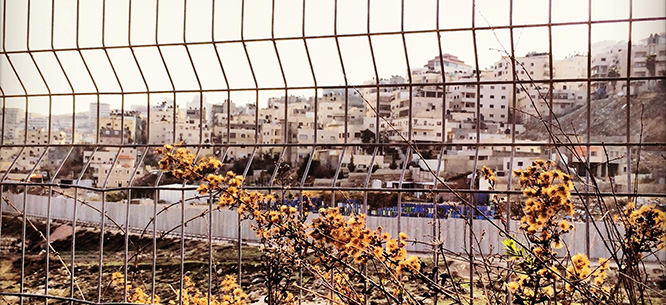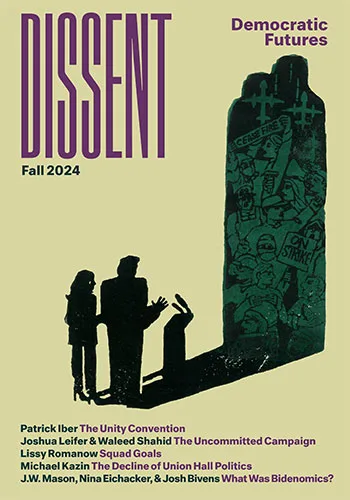Letter From Jerusalem
Letter From Jerusalem
The myth of a united Jerusalem has helped lead us to this horrible moment.

Sheikh Jarrah, East Jerusalem, July 7, 2014 — On Sunday, the Israeli police announced that they had arrested six suspects, whom they described as “Jewish extremists,” for the gruesome murder by burning last week of Mohammed Abu Khdeir, a sixteen-year-old Shuafat resident who left his house before dawn to meet his father at the mosque during Ramadan. The murder was apparently carried out in revenge for the killing of the three Jewish Israeli teens—Naphtali Fraenkel, Gilad Sha’ar and Eyal Yifrach—who were kidnapped hitchhiking home from their West Bank yeshiva on June 12. Last Monday, they were found buried in the ground in a Hebron field, after having been shot.
The aftermath of the Shuafat abduction and murder has led to violent protests in East Jerusalem, spreading from the neighborhood of Shuafat to adjacent neighborhoods and throughout the Arab towns and villages inside of Israel.
Shuafat, home to 35,000 people, is a Palestinian neighborhood that was annexed by Israel and incorporated within the borders of greater Jerusalem after the 1967 war. It lies in the West Bank, on the road to Ramallah that snakes north from Jerusalem. Shuafat is home to an eclectic mix of upper-middle- and working-class Palestinians.
Shuafat also lends its name to the sprawling refugee camp just east of the neighborhood, which is next to the ever-expanding ultra-Orthodox housing development of Ramat Shlomo. These crowded few kilometers exemplify the jigsaw puzzle that has evolved since 1967 and that must be resolved if there is to be any hope of lasting peace and security for all.
Shuafat camp is the only refugee camp within Jerusalem’s borders; it benefits from few city services and is ridden with crime. Though it lies within the Jerusalem city limits, and the municipality is therefore responsible for its welfare, Israeli authorities have largely declined to uphold these responsibilities. Instead, UNRWA (the United Nations Relief and Works Agency) services the camp, which has recently been without both water and trash collection and is rarely, if ever, policed. The separation wall divides much of the camp from the neighborhood of Shuafat and the rest of Jerusalem. However, the teens who rioted these past nights were not from the refugee camp, but from the neighborhood. As one Palestinian friend of mine quipped, Shuafat camp has its own riots. This was an uprising from the neighborhood.
To contemplate what Shuafat looked like in the midst of the riots, imagine the Upper West Side of Manhattan in tatters, with the burnt carcasses of the M104 buses and glass from broken windows littering the sidewalks of Broadway, as rioters roam the streets, their faces covered by bandannas, heaving stones and rocks at the cops. When the stones don’t prove to be enough, they unhinge the sidewalk cement and target the police with the heavy pieces. The police, meanwhile, are not so much trying to gain quiet as handle crowd control in a somewhat awkward and counter-productive matter.
I talked to a few Shuafat residents today who offered several reasons for the neighborhood’s explosion. One is that the boys, as irrational as it may be, perceive the light rail line as an incentive for the settlers and Jewish extremists to travel to their neighborhood. This is ironic because, typically, one-quarter of the passengers from the train line live in Shuafat; it has proven to be a boon to the residents making travel easier for shopping and work.
Another reason for the riots is that thousands of Shuafat teenage boys are caught in an abyss, feeling that they belong neither to a Palestinian entity or to the state of Israel. Though they are Jerusalem citizens, they are alienated from the Jerusalem municipality and from Israel.
Their violent reaction to the murder of Mohammed Abu Khdeir is no surprise. Anyone watching what has been at best a languid peace process over these past years, and now the complete collapse of negotiations, could have predicted that a fire would erupt. Moreover, the rabid building for Jewish extremists inside of Arab neighborhoods in East Jerusalem and the lack of adequate building permits for Arab residents has angered the population. City services are scant. The atmosphere in the city fuels discontent. For example, each June on Jerusalem Day, the fiercely nationalist holiday that marks the forceful Israeli unification of Jerusalem in 1967, the police allow tens of thousands of right-wing teens and their leaders to stridently march through Arab neighborhoods with megaphones through which they shout nationalist slogans, hailing their sovereignty over the streets.
Shuafat citizens, like the rest of the 300,000 Palestinians who live inside the greater Jerusalem municipal border, consider themselves to be living under Israeli occupation and yearn for a Palestinian state to which they can pledge their allegiance. Though they are Jerusalem residents, which makes them eligible for Israeli citizenship, they have uniformly rejected citizenship and instead hold permanent resident status, which means that they pay taxes to the state and have the freedom to travel within Israel and to vote in municipal elections (though not national elections). Still, their lives veer eastward to a future Palestine—in politics, culture, television, education, and often in business.
These Jerusalemites have existed as ghosts to the majority of Israeli Jews and American Jews who don’t usually travel east of the holy basin in the Old City and who have no conception of Arab Israelis’ daily lives or desires. Palestinians in East Jerusalem yearn for their portion of Jerusalem to become Al Quds, the capital of a future Palestinian state. Aside from the live wire of the light rail line, they are disconnected from life in the capital—and now that, too, is (at least temporarily) no more.
The message has become painfully clear. The myth of a united Jerusalem has helped lead us to this horrible moment.
Yesterday, cleanup started in the neighborhood. The mourning tent set up by the aggrieved family is a sea of calm amidst the memory of the riots. Israeli police are stationed within a polite distance of the mourners. The city workers are clearing the streets and fixing the rail stations, though reportedly it will take months and millions of shekels to repair the rail line itself.
Is there a silver lining in all of this bloodshed? Maybe. From now on, the fantasy of a united Jerusalem will have to be seriously discussed in any future negotiations. Furthermore, the concerns of the 300,000 Palestinians living within the municipal borders of the city will have to be taken into consideration. If they are not, then not only did Mohammed, Naphtali, Gilad, and Eyal die in vain, but there is certain to be another eruption before too long.
Just because Jerusalem has to be shared, it doesn’t mean that it has to be physically divided. There are proposals for rethinking Jerusalem to create two capitals for two peoples that also protect the holy sites for all those who hold them in reverence. These proposals create a pragmatic option that could create a true city on the hill. As I detailed in a previous Dissent article, there are well thought-out plans to create a city that will be open, but function as a capital for Israel and a capital for Palestine. As reported recently in Haaretz, there are detailed architectural blueprints available for anyone who wants to consider this option; they would create a city that is aesthetically pleasing and practically divided. Maybe the path of the rail line, now broken into pieces, traces the way toward such a solution.
There is a desperate need for visionaries in this part of the world today. Perhaps the grieving parents of the murdered children can help to lift the blinders of wishful thinking and reset the stage for a pragmatic solution to the Israeli–Palestinian wars. So far, statements coming from the mourning families have been generous in spirit. If the politicians—on both sides—don’t rise to the occasion, then there is tragically no doubt that there will be more deaths and that Jerusalem, the holy of holies, will writhe in more blood born from the fanatics who won’t budge and the politicians who abet them.
Jo-Ann Mort is a member of the Dissent editorial board. She frequently writes about Israel and Palestine.




